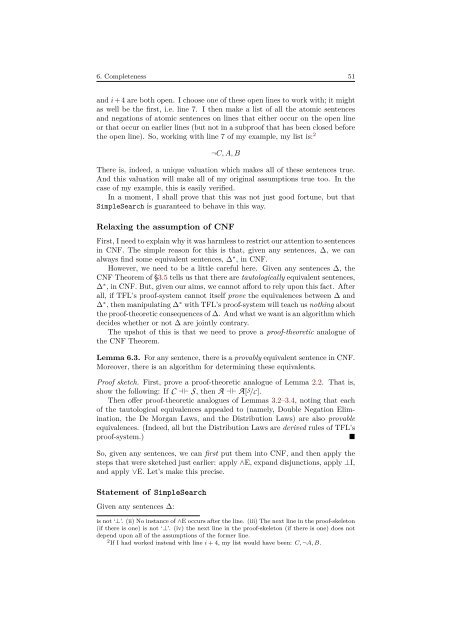Metatheory - University of Cambridge
Metatheory - University of Cambridge
Metatheory - University of Cambridge
Create successful ePaper yourself
Turn your PDF publications into a flip-book with our unique Google optimized e-Paper software.
6. Completeness 51<br />
and i+4 are both open. I choose one <strong>of</strong> these open lines to work with; it might<br />
as well be the first, i.e. line 7. I then make a list <strong>of</strong> all the atomic sentences<br />
and negations <strong>of</strong> atomic sentences on lines that either occur on the open line<br />
or that occur on earlier lines (but not in a subpro<strong>of</strong> that has been closed before<br />
the open line). So, working with line 7 <strong>of</strong> my example, my list is: 2<br />
¬C, A, B<br />
There is, indeed, a unique valuation which makes all <strong>of</strong> these sentences true.<br />
And this valuation will make all <strong>of</strong> my original assumptions true too. In the<br />
case <strong>of</strong> my example, this is easily verified.<br />
In a moment, I shall prove that this was not just good fortune, but that<br />
SimpleSearch is guaranteed to behave in this way.<br />
Relaxing the assumption <strong>of</strong> CNF<br />
First, I need to explain why it was harmless to restrict our attention to sentences<br />
in CNF. The simple reason for this is that, given any sentences, ∆, we can<br />
always find some equivalent sentences, ∆ ∗ , in CNF.<br />
However, we need to be a little careful here. Given any sentences ∆, the<br />
CNF Theorem <strong>of</strong> §3.5 tells us that there are tautologically equivalent sentences,<br />
∆ ∗ , in CNF. But, given our aims, we cannot afford to rely upon this fact. After<br />
all, if TFL’s pro<strong>of</strong>-system cannot itself prove the equivalences between ∆ and<br />
∆ ∗ , then manipulating ∆ ∗ with TFL’s pro<strong>of</strong>-system will teach us nothing about<br />
the pro<strong>of</strong>-theoretic consequences <strong>of</strong> ∆. And what we want is an algorithm which<br />
decides whether or not ∆ are jointly contrary.<br />
The upshot <strong>of</strong> this is that we need to prove a pro<strong>of</strong>-theoretic analogue <strong>of</strong><br />
the CNF Theorem.<br />
Lemma 6.3. For any sentence, there is a provably equivalent sentence in CNF.<br />
Moreover, there is an algorithm for determining these equivalents.<br />
Pro<strong>of</strong> sketch. First, prove a pro<strong>of</strong>-theoretic analogue <strong>of</strong> Lemma 2.2. That is,<br />
show the following: If C ⊢ S, then A ⊢ A[S/C].<br />
Then <strong>of</strong>fer pro<strong>of</strong>-theoretic analogues <strong>of</strong> Lemmas 3.2–3.4, noting that each<br />
<strong>of</strong> the tautological equivalences appealed to (namely, Double Negation Elimination,<br />
the De Morgan Laws, and the Distribution Laws) are also provable<br />
equivalences. (Indeed, all but the Distribution Laws are derived rules <strong>of</strong> TFL’s<br />
pro<strong>of</strong>-system.)<br />
■<br />
⊢<br />
So, given any sentences, we can first put them into CNF, and then apply the<br />
steps that were sketched just earlier: apply ∧E, expand disjunctions, apply ⊥I,<br />
and apply ∨E. Let’s make this precise.<br />
Statement <strong>of</strong> SimpleSearch<br />
Given any sentences ∆:<br />
is not ‘⊥’. (ii) No instance <strong>of</strong> ∧E occurs after the line. (iii) The next line in the pro<strong>of</strong>-skeleton<br />
(if there is one) is not ‘⊥’. (iv) the next line in the pro<strong>of</strong>-skeleton (if there is one) does not<br />
depend upon all <strong>of</strong> the assumptions <strong>of</strong> the former line.<br />
2 If I had worked instead with line i + 4, my list would have been: C, ¬A, B.<br />
⊢
















